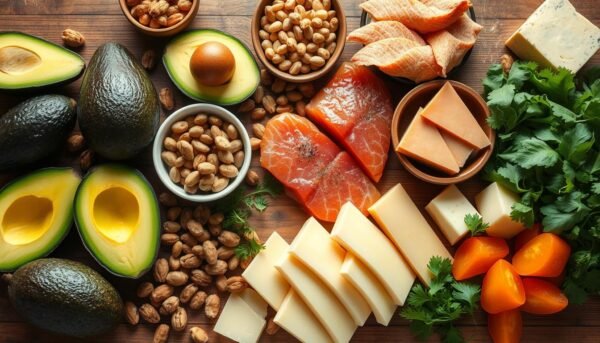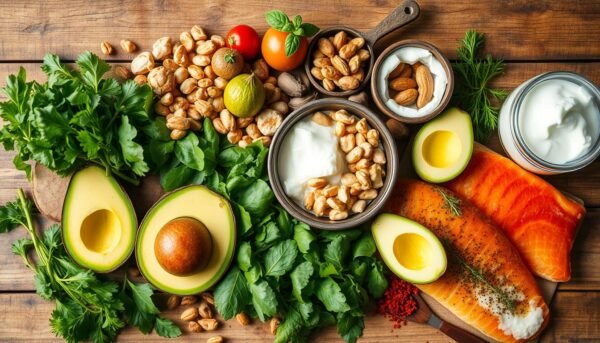Are you tired of struggling with stubborn weight issues? Do you crave a sustainable solution that goes beyond temporary fixes? The ketogenic diet might be what you’re looking for. It’s a low-carb, high-fat way of eating that could change your health and wellness.
But is the keto diet as effective as people say? Let’s explore the science-backed secrets behind this fat-fueled lifestyle.

Understanding the Science Behind Diet Keto
The ketogenic diet is a powerful way to burn fat for energy. It works by cutting down on carbs and entering a state called ketosis. This diet uses our natural ability to burn fat, making us fat-burning machines. Let’s explore how this diet works.
What Happens During Ketosis
When you eat fewer carbs, your body goes into ketosis. In this state, your liver makes ketones from fat. These ketones are a new fuel for your brain and body, lessening the need for glucose from carbs.
The Role of Ketones in Fat Burning
Ketones are key in burning fat. As you get used to ketosis, your body gets better at using fat for energy. This can help you lose weight faster and improve your body shape by using stored fat for energy.
How Your Body Adapts to Fat for Fuel
Switching to a ketogenic diet takes time for your body to adjust. It starts using fat and ketones instead of glucose. This change might cause the “keto flu” at first. But soon, your body gets better at burning fat, leading to lasting weight loss.

| Key Ketogenic Diet Statistics | Value |
|---|---|
| Percentage of calories from fat | 70-75% |
| Percentage of calories from protein | 20-25% |
| Percentage of calories from carbohydrates | 5-10% |
| Optimal macronutrient ratios | No more than 15g of carbs, 1g of protein per kg of body weight, remaining from fats |
Essential Benefits of Following a Ketogenic Lifestyle
Starting a ketogenic journey can bring many benefits. It’s not just about losing weight. The keto diet helps improve your health in many ways.
One big plus is better insulin sensitivity. People with type 2 diabetes or prediabetes see big improvements in blood sugar. This is great news for those with metabolic issues.
The diet also lowers blood pressure, triglycerides, and bad cholesterol. It makes you feel full, helping control hunger and calorie intake.
It might even protect your brain. The keto diet could help those with epilepsy, Alzheimer’s, and Parkinson’s. Ketones in ketosis are good for brain health.
Whether you want to lose weight, improve health, or boost brain function, keto might be the answer. It’s a journey to a healthier, happier you.
| Benefit | Evidence |
|---|---|
| Improved insulin sensitivity | A 2013 meta-analysis showed that people following ketogenic diets lost 2 pounds more than those following low-fat diets over 1 year. |
| Reduced blood pressure and triglycerides | A 2017 review revealed that some people on a keto diet experienced a substantial drop in total cholesterol, LDL cholesterol, and triglycerides while increasing HDL cholesterol. |
| Increased satiety and appetite control | Studies consistently show that people on low-carb diets end up eating far fewer calories. |
| Neuroprotective benefits | The 2019 review suggested that ketones from a keto diet may provide neuroprotective benefits, potentially aiding in preventing or managing conditions like Alzheimer’s disease. |

Getting Started with Diet Keto: A Beginner’s Roadmap
Starting a ketogenic diet is exciting. It’s a step towards a healthier life with less carbs. Let’s look at the first steps to get you going.
Calculating Your Macro Ratios
Success on a keto diet comes from the right mix of nutrients. You should eat 70-75% of your calories from fats, 20-25% from protein, and 5-10% from carbs. Finding your personal macro targets helps you stay in ketosis. Use online tools or a nutritionist to figure out your best ratios.
Planning Your First Week
Planning your first week of meals is key. Eat lots of high-fat foods like meats, fish, eggs, nuts, and oils. These foods keep you full and help your body use fat for energy.
Tips for Transitioning Successfully
- Drink plenty of water and replace lost electrolytes to avoid keto flu symptoms.
- Slowly cut down on carbs over a few weeks for an easier transition.
- Use apps to track your food and make sure you’re in ketosis.
- Join the keto community for support and to celebrate your wins.
With good planning, the right nutrient mix, and a positive attitude, you can smoothly move into a keto lifestyle. Remember, everyone’s journey is different. Be patient, listen to your body, and enjoy the benefits of a fat-based diet.

Foods to Embrace on Your Ketogenic Journey
I’m excited to start my ketogenic lifestyle. I’ll explore tasty and healthy foods that fuel my body. The goal is to eat high-fat, low-carb foods to stay in ketosis.
Healthy fats are key. I’ll eat meats like beef, pork, and lamb. Fatty fish like salmon and tuna are also on my list. Eggs, butter, and cream will be regulars, offering healthy fats and protein.
Cheese, nuts, and seeds will add texture and variety. They’re all high in fat.
I’ll choose low-carb veggies like leafy greens and broccoli. Sometimes, I’ll have small amounts of berries. I’ll drink water, coffee, and unsweetened tea. Sugary drinks are a no-go.
This post may contain affiliate links which means I may receive a commission for purchases made through links. I will only recommend products that I have personally used! Learn more on my Private Policy page.